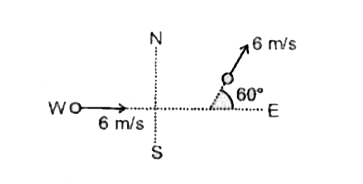A proton in a cyclotron changes its velocity from 30 kms–1 the north of 40 kms–1 the east in 20 s. What is the magnitude of average acceleration during this time ?
2.5kms−2
12.5kms−2
22.5kms−2
32.5kms−2
The correct Answer is:A
To find the magnitude of average acceleration of the proton, we can follow these steps:
Step 1: Identify Initial and Final Velocities
- The initial velocity →V1 is 30 km/s to the north.
- The final velocity →V2 is 40 km/s to the east.
Step 2: Convert Velocities to Vector Form
- We can represent the velocities as vectors:
- →V1=0^i+30^j (where ^i is the east direction and ^j is the north direction)
- →V2=40^i+0^j
Step 3: Calculate Change in Velocity
- The change in velocity Δ→V is given by:
Δ→V=→V2−→V1=(40^i+0^j)−(0^i+30^j)=40^i−30^j
Step 4: Calculate the Magnitude of Change in Velocity
- The magnitude of the change in velocity |Δ→V| can be calculated using the Pythagorean theorem:
|Δ→V|=√(40)2+(−30)2=√1600+900=√2500=50 km/s
Step 5: Calculate Average Acceleration
- Average acceleration →aavg is defined as the change in velocity divided by the time interval:
→aavg=Δ→VΔt=50 km/s20 s=2.5 km/s2
Final Answer
- The magnitude of the average acceleration is 2.5 km/s2.
---
- The initial velocity →V1 is 30 km/s to the north.
- The final velocity →V2 is 40 km/s to the east.
- We can represent the velocities as vectors:
- →V1=0^i+30^j (where ^i is the east direction and ^j is the north direction)
- →V2=40^i+0^j
- The change in velocity Δ→V is given by:
Δ→V=→V2−→V1=(40^i+0^j)−(0^i+30^j)=40^i−30^j
- The magnitude of the change in velocity |Δ→V| can be calculated using the Pythagorean theorem:
|Δ→V|=√(40)2+(−30)2=√1600+900=√2500=50 km/s
- Average acceleration →aavg is defined as the change in velocity divided by the time interval:
→aavg=Δ→VΔt=50 km/s20 s=2.5 km/s2
- The magnitude of the average acceleration is 2.5 km/s2.
Topper's Solved these Questions
Similar Questions
A particle is moving east wards with a velocity of 15ms−1. In a time of 10 s, the velocity changes to 15ms−1 northwards. Average acceleration during this time is (in ms−2)
View SolutionAn athelete takes 2.0 s to reach his maximum speed of 18.0 km/h. What is the magnitude of his average acceleration?
View SolutionA man moves on his motorbike with 54km/h and then takes a U-turn and containues to move with same velocity The time of U-turn is 10s. Find the magnitude of average acceleration during U-turn.
View SolutionThe velocity of an object changes from 50 m/s to 60 m/s in 20 seconds. What is the average acceleration of the object over that interval?
View SolutionA particle is moving eastwards with a speed of 6 m/s. After 6 s, the particle is found to be moving with same speed in a direction 60∘ north of east. The magnitude of average acceleration in this interval of time is

View SolutionA train moving at a constnt velocity of 54 km/hr moves eastwards for 30 minuts, then due north with the same speed for 40 minutes. What is the average velocity of the train during this run? (in km/hr)
View SolutionA bird is flying towards north with a velocity 40kmh−1 and a train is moving with velocity 40kmh−1 towards east. What is the velocity of the bird boted by a man in the train ?
View SolutionA body is moving with velocity 30m/s towards east. After 10s its velocity becomes 40m/s towards north. The average acceleration of the body is.
View SolutionA body is moving with velocity 30m/s towards east. After 10s its velocity becomes 40m/s towards north. The average acceleration of the body is.
View SolutionWhat is the work to be done to increase the velocity of a car from 30kmh−1 to 60kmh−1 if the mass of the car is 1500kg ?
View Solution
